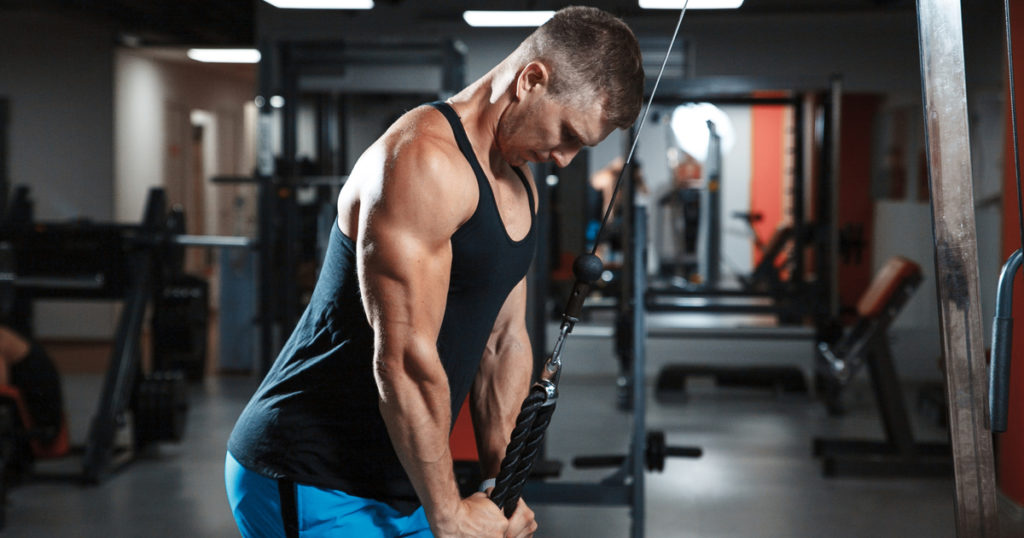The triceps play a crucial role in lifting, sports, and everyday life. They play the incredibly important part of extending the elbow and help stabilize the shoulder extension, so yeah, without the triceps we would all be pretty limited in life.
Much like every muscle group, the triceps need strategy behind how they are trained especially when trying to capitalize on results. Instead of simply giving a list of the best triceps exercises, we thought it would be a good idea to publish an article that brings up some practical triceps training guidelines that everyone can benefit from using.
At the root of everything below, it’s important to recognize that consistency, progressive overload, and exercise selection all need to be dialed in for these guidelines to be relevant.

1. Consider the Angle of the Shoulder
The triceps are composed of three mains heads (sometimes individuals have four), and these three heads have all been suggested to respond slightly differently when the shoulder is in various degrees of elevation.
The three main triceps heads include:
- Long Head
- Medial Head
- Lateral Head
The triceps brachii heads origin points all vary, which is key to understand because this can help suggest which heads will be most active during various positions. A study published in 2018 in Acta Orthop Traumatol Turc assessed the different roles of the triceps brachii heads when performing elbow extension at various shoulder elevations. (1)
Essentially, the study authors wanted to investigate if the triceps’ heads responded differently during elbow extension at various shoulder angles. Interestingly, authors noted that each triceps head has a slightly different force pattern and each head plays a slightly different role when the shoulder is elevated at different points.
Contrary to conventional triceps training wisdom, the authors suggested that the long head of the triceps is most active when there is a lower shoulder elevation present, while the medial head is most active when in higher elevations.
For a cool visual with a graphic, check out the great post from Chris Beardley’s Instagram page.
Takeaway Guideline: While research is still relatively thin on this topic, it’s brings up some food for thought when it comes to training elbow extension at various shoulder heights. A mixture of angles will likely be best for most trainees who want to provide ample stimulus to all of the heads.
2. Consider Total Training Volume
Another important guideline to consider when training the triceps is total training volume. Since the triceps play a large role in pressing, then it’s important to recognize the frequency in which they’re being trained both directly and indirectly.
This is when prioritizing training goals and adaptations is so important in regard to triceps growth. While training frequency and style will be individual, we can make some basic suggestions below for different training populations.
- Weightlifters/Powerlifters: This population may want to limit direct triceps training that doesn’t relate directly to the specificity of what they need the triceps for, a.k.a lockout strength and overhead stability. For example, if this population is fatiguing the triceps during a “bodybuilding” style day before a workout day that focuses on competition movements, then they should reconsider their total triceps training volume.
- Bodybuilders/Recreational Lifters: This population will benefit with more direct triceps training if the goal is growth, strength, and hypertrophy.
- Sport Athletes: Athletes will have to factor in their in-season, off-season, and sport demands to create a training volume and frequency that doesn’t limit performance.
Lifters and athletes will need to experiment with different frequencies and volumes to compare what their body responds best with. At the end of the day, fatigue can be a great indicator as to helping suggest when volume should be scaled back.
Takeaway Guideline: Consider the main goals and needs of training, then create a program that accounts for exercise selection and the specificity of movements to create the highest turnover for performance.

3. Train Heavy and Light
On top of slightly varying in function at different positions, the triceps brachii also vary in their muscle fiber composition. It’s suggested that the triceps are composed of a mixture of ast twitch and slow twitch muscle fibers with a slightly higher composition leaning towards fast twitch fibers. (2)
This is valuable information because different muscle fibers have the potential to respond better and worse to different forms of training. Fast twitch fibers generally respond well to heavier training that has a strength and power focus, while slow twitch fibers often respond best to higher volumes and endurance focused work.
Keeping this in mind and going with conventional training wisdom, it appears that varying training will be best for creating well-rounded triceps growth. Train them heavy, and don’t be afraid to hit lighter sets with high volume. It’s also worth considering the fact that muscle fibers have the potential to change over time, so if an adaptation like strength is the main goal, then biasing the heavy:light triceps training ratio could be worth exploring for optimal growth.
Takeaway Guideline: Vary and bias training towards adaptations being sought out for well-rounded triceps growth.
In Sum
The above are general guidelines to keep in mind when training the triceps (and any muscle, really). The most important aspect to consider is to blend evidence with experience to create the most favorable outcomes based on your goals and needs.
References
1. Kholinne, E., Zulkarnain, R., Sun, Y., Lim, S., Chun, J., & Jeon, I. (2018). The different role of each head of the triceps brachii muscle in elbow extension. Acta Orthopaedica Et Traumatologica Turcica, 52(3), 201-205.
2. JE, L. (2020). Compartmentalization in the triceps brachii motoneuron nucleus and its relation to muscle architecture. – PubMed – NCBI .
Feature image from K-STUDIO / Shutterstock